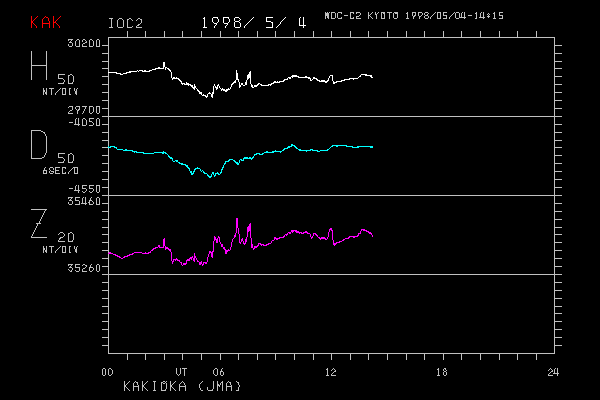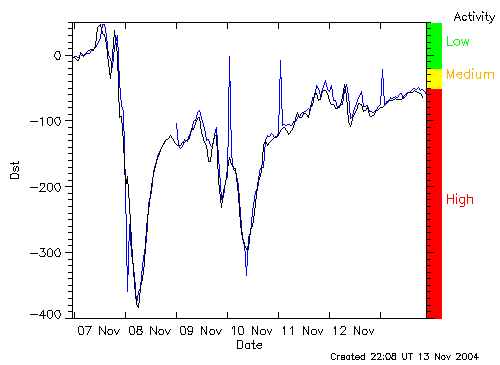 The loss process involves so-called charge exchange collisions.
The loss process involves so-called charge exchange collisions.
The neutral hydrogen atoms of the geocorona move quite slowly and have much less energy than ring current ions (if they had more, the Earth's gravity would not hold them!). A collision often ends up transferring an electron from the hydrogen atom to the ring-current ion, without much change in the particles' energies.
The hydrogen atom, having lost an electron, becomes an ion (proton), and
because of its low energy, contributes very little to the ring current. On the
other hand, the ring current ion which has gained an electron is now
neutralized, becoming a fast neutral atom with a great deal of energy. Since
the Earth's magnetic field can only trap charged particles, the fast atom
usually disappears quickly into distant space. In this way the "charge
exchange" process gradually removes newly added particles from the ring current.
Only the more energetic ones remain, since their probability of undergoing
charge exchange is much lower.
This process has an unusual application, allowing the ring current to observed remotely, a bit like the way astronomers observe distant stars through their
telescopes. Astronomers use light, which moves in straight lines. Similarly,
if one could build a camera that used energetic neutral atoms (ENA) created in the ring current by charge exchange, it might be able to picture the ring current, too, since ENAs also move along straight lines.
The "Image" mission using such a camera is in fact scheduled for launch in the year 2000. Technically this is a rather difficult feat,
because the number of ENAs coming from the ring current, especially outside
magnetic storms, is rather small. A pilot experiment of this type ran for five
weeks aboard the Swedish satellite Astrid, launched in December 1994, and
produced some very simple ENA images.
Storms and Substorms
What creates a magnetic storm?
Substorms have now been studied for many years, from space and from the
ground. Their details vary from one event to the next, just as thunderstorms in the atmosphere never seem alike, but many scientists have nevertheless concluded that they are a fundamental mode of energy release and of particle acceleration.
Magnetic storms usually have a well-defined trigger--often the arrival of an interplanetary shock. Their main effect on the magnetosphere is the injection of many
energetic ions and electrons from the tail, causing the ring current to grow
significantly. Yet substorms also inject such particles, as was shown in 1971 by the instruments aboard the synchronous ATS-1, an experimental communication satellite with a "piggyback" scientific payload. Many other satellites have studied substorm injections since then, confirming that substorms also injected ions and electrons into the ring current--only, not as many, penetrating less far and with lower average energy.
Apart from its sudden initiation, is a magnetic storm primarily a series of large and intense substorms? That was apparently the view of Sydney Chapman (1888-1970), distinguished researcher of magnetic storms, who introduced the term "substorm" to suggest precisely that idea. Chapman noted in 1963 that the same storms which at near-equator observatories, e.g. in Hawaii, followed simple curves of growth and decay, in Alaska seemed to consist of a number of distinct "sub-storms."
Substorms however exist at other times as well (as S. Akasofu, Chapman's
student, discovered soon afterwards). They do not need much of a stimulus: during times of southward interplanetary field, the tail seems to quickly reach the brink of instability, and small changes in the solar wind can then precipitate a substorm. Although magnetic storms seem to come from more powerful sources, such as the arrival of interplanetary shocks, they too seem to require (usually) a southward IMF. A strong shock arriving with a northward IMF may shake the magnetosphere, but not to the point of creating a storm. Thus much still remains to be clarified.
M-Regions and Coronal Holes
The connection between magnetic storms and sunspots was well established
around the turn of the century. When large active sunspots were visible, big
magnetic storms were much more likely. In today's terminology one might say
that the intense field of sunspots was likely to lead to sudden releases of
magnetic energy, manifested by flares and coronal mass ejections, and those in their turn sent out fast interplanetary plasma clouds whose shock fronts caused magnetic storms.
The relation between sunspots and smaller magnetic storms, however, seemed
less firm. In 1904 E.W. Maunder of the Royal Observatory in Greenwich, England, proposed that many such storms belonged to an entirely different class, tending to recur at intervals of 27 days, the Sun's rotation period. It was as if something on the rotating Sun was beaming those storms at us. However,
attempts to identify those regions on the Sun suggested that they were bland and featureless, containing no sunspots. Astronomers named them "M
regions" (M for magnetic storms), and for a long time no one had a clue about what set them apart.
Space observations finally pointed the way. In 1962 the space probe Mariner 2, on its way to Venus, noted that the solar wind contained recurrent fast
streams, whose sources appeared to rotate with the Sun. The arrival of such
streams was found to trigger moderate storms of the kind studied
by Maunder, but their cause was still unclear.
A decade later, in 1973, astronauts aboard the space station Skylab observed
the Sun in soft X-rays. Such pictures, like the one on the right which was taken by the Japanese satellite Yohkoh, highlight the hot spots of the corona:

Click here for a full size version of this image.
Bright X-ray regions in the corona were often associated with sunspots,
which (it seemed) pumped extra energy into the regions above them. In contrast, the elusive "M-regions" turned out to be the dark areas
in-between, named "coronal holes." Apparently, the arches and loops of magnetic
field lines produced in sunspots trapped and held back solar plasma, hindering
it from flowing away as solar wind. In "coronal holes", on the other hand, the
magnetic field was weaker and its field lines stuck out straight into space,
providing an easy route along which solar wind could flow. Thus although such regions were
cooler than their neighbors, they were better sources of solar wind. The polar caps of the Sun, away from the sunspot belts, form two very large "coronal holes", and the solar wind emanating from them was expected to be fast and steady, a prediction confirmed by Ulysses. The "holes" which produce fast solar wind streams at Earth are generally extensions of the polar ones.
Your own Instrument for Observing Magnetic Storms
A sensitive and sophisticated instrument (and a much more challenging project) is described in the Scientific American of March 2000, pages 94-95.
Further Exploration
Dr. George Carruthers, mentioned above in connection with the photograph of the geocorona from the Moon's surface, has been one of the few Black Americans to make a notable mark in space research. More about him, here.
Questions from Users:
***
Magnetometer for Observing Magnetic Storms
***
"Soda-Bottle Magnetometer"
|


 The loss process involves so-called charge exchange collisions.
The loss process involves so-called charge exchange collisions. 